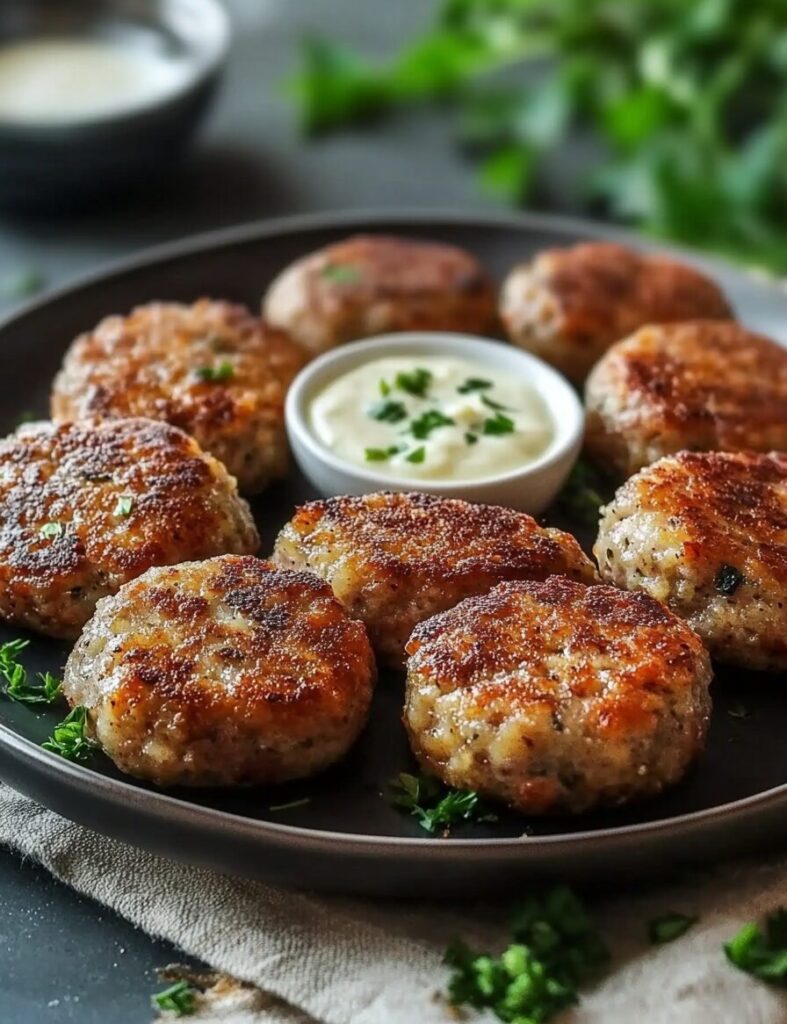Frikadellen, often called German hamburgers, are a beloved staple of German cuisine. These flavorful meat patties are known for their crispy exterior and juicy interior, making them perfect for a hearty meal, a picnic snack, or even a quick sandwich. They are easy to make, highly customizable, and pair well with a variety of sides.
Ingredients:
- Meat Mixture:
- 1 lb ground beef
- 1 lb ground pork
- 1 small onion, finely chopped and sautéed
- 1 egg
- 3/4 cup breadcrumbs
- 2 tbsp Dijon mustard
- 2 tbsp fresh parsley, finely chopped
- 1 tsp salt
- 1/2 tsp black pepper
- 1/2 tsp paprika (optional)
- Cooking:
- 2 tbsp vegetable oil for frying
Directions:
- Prepare the Onion:
- Sauté the finely chopped onion in a small amount of oil until softened and translucent. Allow it to cool.
- Mix the Ingredients:
- In a large bowl, combine ground beef, ground pork, sautéed onion, egg, breadcrumbs, Dijon mustard, parsley, salt, pepper, and paprika. Mix gently until well incorporated.
- Shape the Patties:
- Divide the mixture into 8 equal portions. Shape each portion into a patty, about 1 inch thick.
- Cook the Frikadellen:
- Heat vegetable oil in a large skillet over medium heat. Cook the patties for 5–6 minutes on each side, or until golden brown and fully cooked through.
- Serve:
- Serve hot with your favorite sides, such as potato salad, sauerkraut, or a fresh green salad.
Nutritional Information:
- Calories: ~250 kcal per patty (based on an average serving size)
- Protein: ~20g
- Fat: ~15g
- Carbohydrates: ~10g
- Fiber: ~1g
Enjoy these versatile, delicious Frikadellen with a side of mustard or tucked into a bun for a German-style burger experience!
Exploring the Allure of Frikadellen: A German Culinary Delight
Frikadellen, often fondly referred to as German hamburgers, hold a special place in German culinary tradition. These succulent meat patties are a harmonious blend of simple ingredients and bold flavors, making them a beloved dish across generations. With their golden-brown exterior, juicy interior, and versatility in preparation, Frikadellen have become a go-to comfort food, not just in Germany but among food enthusiasts worldwide.
Origins and Cultural Significance
Frikadellen trace their origins back to Europe, where similar recipes exist under various names. In Germany, they are a staple of home-cooked meals and are often featured in beer gardens, picnics, and festive gatherings. Unlike the American hamburger, Frikadellen are not served with a bun by default, emphasizing the patty itself as the star of the dish.
Traditionally made with a combination of ground beef and pork, these patties showcase the resourcefulness of German cuisine, which thrives on using simple, accessible ingredients to create hearty and satisfying meals. Frikadellen are often accompanied by iconic German sides like potato salad, sauerkraut, or a crusty slice of rye bread, enhancing their appeal as a complete and comforting dish.
What Sets Frikadellen Apart?
At first glance, Frikadellen might resemble other types of meat patties, but several unique elements set them apart. Their preparation incorporates a balance of textures and flavors. Sautéed onions add a subtle sweetness and moisture, breadcrumbs provide a soft yet firm structure, and Dijon mustard lends a tangy depth. The addition of parsley gives a fresh, herbal note, while optional spices like paprika can introduce a hint of smokiness.
Unlike heavily seasoned patties found in other cuisines, Frikadellen are intentionally subtle, allowing the natural flavors of the meat to shine through. This makes them versatile for pairing with a range of accompaniments, from creamy potato dishes to tangy pickled vegetables.
The Art of Customization
One of the most appealing aspects of Frikadellen is their adaptability. While the classic recipe features a mix of beef and pork, other variations incorporate veal, turkey, or even plant-based alternatives for a vegetarian twist. Additional ingredients like grated carrots, garlic, or shredded cheese can be added to the mixture for unique flavor profiles.
Frikadellen can also be customized to suit dietary preferences. For example, gluten-free breadcrumbs can be used for those avoiding gluten, and leaner cuts of meat can reduce fat content. These modifications allow cooks to experiment while preserving the essence of this cherished dish.
Versatility in Serving
Frikadellen’s versatility extends to how they are served. While they are traditionally enjoyed as a standalone dish with sides, they also shine in creative presentations. For a quick and satisfying meal, Frikadellen can be tucked into a bun with lettuce, tomato, and condiments for a German-style burger. They make an excellent addition to lunchboxes, maintaining their flavor even when served cold. Paired with a dollop of mustard or a tangy horseradish sauce, they offer a burst of complementary flavors.
In Germany, Frikadellen are often served at room temperature during picnics or outdoor events, highlighting their practicality as a portable and filling snack. Their ability to be eaten hot, warm, or cold adds to their charm, making them a dish for all seasons.
Nutritional Profile
Frikadellen provide a balanced nutritional profile that appeals to those seeking a satisfying yet nourishing meal. With approximately 250 calories per patty, they offer a moderate calorie count suitable for various diets. Each patty delivers a significant protein boost, supporting muscle health and satiety. The inclusion of breadcrumbs and onions contributes carbohydrates and a touch of fiber, while the combination of meats offers healthy fats to enhance flavor and texture.
Cultural Variations
Though firmly rooted in German cuisine, Frikadellen share similarities with other international dishes, illustrating the universal appeal of meat patties. For instance, Denmark’s Frikadeller are often smaller and served with gravy, while Sweden’s meatballs share a similar ingredient base but are typically paired with lingonberry sauce. These regional interpretations highlight how simple ingredients can be transformed into iconic dishes through cultural nuances.
Modern Takes on Frikadellen
In today’s culinary landscape, chefs and home cooks alike are reinventing Frikadellen to cater to contemporary tastes and trends. Adding exotic spices like cumin or coriander introduces a global twist, while incorporating plant-based proteins aligns with the growing demand for vegetarian and vegan options. These modern adaptations ensure that Frikadellen remain relevant and accessible to a diverse audience.
Conclusion: The Timeless Appeal of Frikadellen
Frikadellen are more than just meat patties—they represent the heart of German comfort food and a testament to the simplicity and creativity of traditional cooking. Whether served as a main course, a snack, or part of a larger meal, these versatile patties never fail to delight. Their adaptability to different tastes, occasions, and dietary needs ensures they remain a beloved dish for generations to come.
As you enjoy a plate of Frikadellen, you’re not just savoring a delicious meal—you’re experiencing a piece of German heritage that has stood the test of time. With their rich history, customizable nature, and universal appeal, Frikadellen are a culinary treasure worth exploring and sharing.
Print
Authentic German Frikadellen (German Hamburgers)
Description
Frikadellen, often called German hamburgers, are a beloved staple of German cuisine. These flavorful meat patties are known for their crispy exterior and juicy interior, making them perfect for a hearty meal, a picnic snack, or even a quick sandwich. They are easy to make, highly customizable, and pair well with a variety of sides.
Ingredients
- Meat Mixture:
- 1 lb ground beef
- 1 lb ground pork
- 1 small onion, finely chopped and sautéed
- 1 egg
- 3/4 cup breadcrumbs
- 2 tbsp Dijon mustard
- 2 tbsp fresh parsley, finely chopped
- 1 tsp salt
- 1/2 tsp black pepper
- 1/2 tsp paprika (optional)
- Cooking:
- 2 tbsp vegetable oil for frying
Instructions
- Prepare the Onion:
- Sauté the finely chopped onion in a small amount of oil until softened and translucent. Allow it to cool.
- Mix the Ingredients:
- In a large bowl, combine ground beef, ground pork, sautéed onion, egg, breadcrumbs, Dijon mustard, parsley, salt, pepper, and paprika. Mix gently until well incorporated.
- Shape the Patties:
- Divide the mixture into 8 equal portions. Shape each portion into a patty, about 1 inch thick.
- Cook the Frikadellen:
- Heat vegetable oil in a large skillet over medium heat. Cook the patties for 5–6 minutes on each side, or until golden brown and fully cooked through.
- Serve:
- Serve hot with your favorite sides, such as potato salad, sauerkraut, or a fresh green salad.







